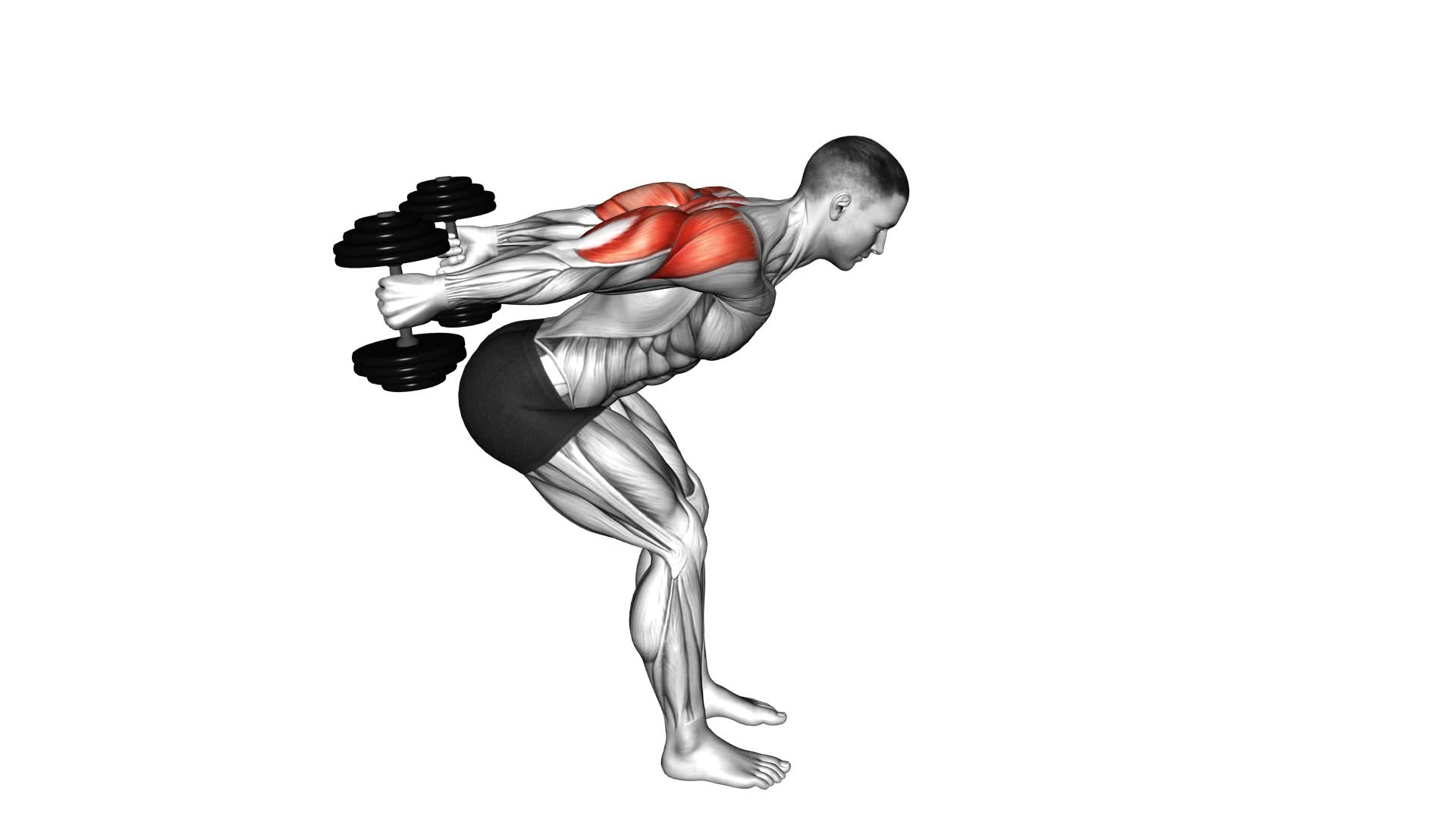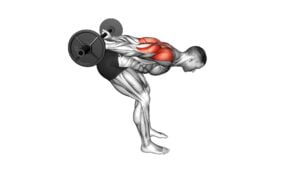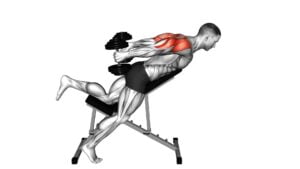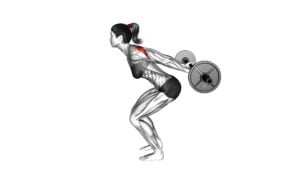Dumbbell Bent Over Reverse Raise (skier) (male) – Video Exercise Guide & Tips

Looking to target your back and shoulder muscles? Try the dumbbell bent over reverse raise!
Watch This Exercise Video
This video exercise guide will show you the proper form and technique.
Whether you're a beginner or an advanced athlete, there are variations and modifications to suit your needs.
Maximize your results and avoid common mistakes with these helpful tips.
Get ready to strengthen and tone with this effective exercise.
Let's get started!
Key Takeaways
- The Dumbbell Bent Over Reverse Raise exercise targets the posterior deltoids and improves overall shoulder strength and stability.
- It also strengthens the traps, rhomboids, and erector spinae muscles, enhancing posture and reducing the risk of injuries.
- Using proper form and technique, such as maintaining a stable stance and avoiding swinging or using momentum, is crucial for maximizing the benefits and preventing injury.
- The exercise can be modified for different fitness levels, such as using lighter weights for beginners or increasing the weight for advanced athletes.
Benefits of the Dumbbell Bent Over Reverse Raise
One major benefit of the Dumbbell Bent Over Reverse Raise is that it improves your overall shoulder strength and stability. This exercise specifically targets the posterior deltoids, which are the muscles located at the back of your shoulders. When performing the Dumbbell Bent Over Reverse Raise, you engage these muscles to lift the dumbbells out to the sides, leading to increased muscle activation in the posterior deltoids.
By strengthening your shoulder muscles, you can improve your posture and reduce the risk of injuries, such as shoulder impingement or rotator cuff tears. The Dumbbell Bent Over Reverse Raise also helps to enhance shoulder stability, making it easier to perform other upper body exercises with proper form and technique.
Additionally, this exercise can contribute to better overall upper body aesthetics. Developing well-defined posterior deltoids can create a more balanced and sculpted appearance, especially when combined with a comprehensive shoulder workout routine.
Equipment Needed for the Exercise
To perform the Dumbbell Bent Over Reverse Raise, you'll need a pair of dumbbells. Dumbbells are versatile and convenient pieces of equipment that can be found in most gyms or purchased for home use. There are different types of dumbbells available, including fixed-weight dumbbells and adjustable dumbbells. Fixed-weight dumbbells are pre-set to a specific weight and are ideal if you prefer a consistent resistance level. On the other hand, adjustable dumbbells allow you to change the weight by adding or removing plates, giving you more flexibility in your workout.
Before starting the Dumbbell Bent Over Reverse Raise, it's crucial to properly warm up your body. Warming up helps increase blood flow to your muscles, preparing them for the upcoming exercise. It also helps reduce the risk of injury. A good warm-up can include light cardio exercises like jogging or jumping jacks, followed by dynamic stretches that target the muscles involved in the Dumbbell Bent Over Reverse Raise. Take your time and ensure that your body feels loose and ready before proceeding with the exercise.
Proper Form and Technique
To perform the Dumbbell Bent Over Reverse Raise with proper form and technique, ensure that you maintain a stable stance and grip the dumbbells firmly. Here are some key tips to help you execute this exercise correctly:
- Start by standing with your feet shoulder-width apart and your knees slightly bent. This stable stance will provide a strong foundation for the movement.
- Hold a dumbbell in each hand with an overhand grip. Make sure to keep your wrists straight and your palms facing your body.
- Bend forward at the hips, keeping your back straight and your core engaged. This bent over position will target your posterior shoulder muscles effectively.
- With your arms fully extended, raise the dumbbells out to the sides until they reach shoulder height. Keep your elbows slightly bent throughout the movement.
- Lower the dumbbells back down slowly and with control, returning to the starting position.
By following these proper form and technique guidelines, you can maximize the effectiveness of the Dumbbell Bent Over Reverse Raise.
Remember to avoid these common mistakes: using excessive weight, swinging the dumbbells, or rounding your back. Additionally, tracking your progress by recording the weight used and the number of repetitions performed can help you monitor your improvement over time.
Stick to the correct form, track your progress, and watch your shoulder muscles strengthen and grow.
Variations and Modifications for Beginners and Advanced Athletes
Try incorporating different variations and modifications of the Dumbbell Bent Over Reverse Raise to challenge yourself and cater to your fitness level.
If you're a beginner, there are several modifications you can make to make the exercise more manageable. One option is to use lighter dumbbells or even start with just your body weight. This will allow you to focus on mastering the correct form and technique before adding additional weight.
Another modification for beginners is to perform the exercise in a standing position instead of bent over. This will help to reduce the strain on your lower back and make it easier to maintain proper form.
For advanced athletes looking to take the Dumbbell Bent Over Reverse Raise to the next level, there are several variations you can try. One option is to increase the weight of the dumbbells to challenge your muscles even more. You can also try performing the exercise on an unstable surface, such as a balance board or Bosu ball, to engage your core muscles and improve your balance.
Another advanced variation is to perform the exercise with a single arm instead of both arms simultaneously. This will increase the difficulty and require more stability and control.
Remember to always listen to your body and choose variations and modifications that are appropriate for your fitness level. By incorporating these changes, you can continue to progress and challenge yourself with the Dumbbell Bent Over Reverse Raise.
Tips for Maximizing Results and Avoiding Common Mistakes
To optimize your results and prevent common errors, follow these tips when performing the Dumbbell Bent Over Reverse Raise exercise:
- Maintain proper form: Keep your back straight, chest out, and core engaged throughout the movement. Avoid rounding your shoulders or arching your back.
- Start with lighter weights: This exercise targets smaller muscles in the shoulders and back, so it's important to start with lighter dumbbells to ensure proper technique and prevent injury.
- Control the movement: Focus on the eccentric (lowering) phase of the exercise by slowly lowering the dumbbells back to the starting position. This will engage the muscles more effectively and enhance your results.
- Avoid swinging or using momentum: Keep the movement controlled and avoid using momentum to lift the dumbbells. This will ensure that the targeted muscles are properly engaged and working to their full potential.
- Gradually increase the weight: As you become stronger and more comfortable with the exercise, gradually increase the weight of the dumbbells to continue challenging your muscles and making progress.
Frequently Asked Questions
How Many Sets and Reps Should I Do for the Dumbbell Bent Over Reverse Raise?
To determine how many sets and reps you should do for the dumbbell bent over reverse raise, it's important to consider your fitness level and goals. Generally, starting with 2-3 sets of 10-12 reps is a good place to begin.
As you become more comfortable and stronger, you can gradually increase the number of sets and reps. Remember to listen to your body and adjust the intensity accordingly.
Always consult with a fitness professional for personalized guidance.
Can I Perform the Dumbbell Bent Over Reverse Raise With a Barbell Instead of Dumbbells?
Yes, you can perform the dumbbell bent over reverse raise with a barbell instead of dumbbells. While the exercise is traditionally done with dumbbells, using a barbell can provide a different challenge and engage your muscles in a slightly different way.
However, be sure to start with a lighter weight and focus on maintaining proper form to avoid injury.
The dumbbell bent over reverse raise is a great exercise for improving posture and strengthening your back muscles.
Is the Dumbbell Bent Over Reverse Raise a Good Exercise for Targeting the Lower Back Muscles?
The dumbbell bent over reverse raise is an effective exercise for targeting the lower back muscles. It helps to strengthen and stabilize the muscles in your lower back, promoting better posture and reducing the risk of injury.
To perform this exercise correctly, stand with your feet hip-width apart, hinge forward at the hips, and raise the dumbbells out to the sides in a skier-like motion. Remember to engage your core and maintain a slight bend in your knees for proper form.
Can I Incorporate the Dumbbell Bent Over Reverse Raise Into My Leg Day Workout Routine?
Yes, you can definitely incorporate the dumbbell bent over reverse raise into your leg day workout routine.
This exercise is great for targeting your leg muscles, including the hamstrings, glutes, and lower back.
By adding the dumbbell bent over reverse raise to your leg day routine, you can increase the intensity and challenge your legs in a different way.
It's a versatile exercise that can help you build strength and improve your overall leg development.
Are There Any Alternatives to the Dumbbell Bent Over Reverse Raise That Target the Same Muscle Groups?
If you're looking for alternatives to the dumbbell bent over reverse raise that target the same muscle groups, there are a few options you can try.
One variation is the cable reverse fly, which also works your rear deltoids.
Another option is the seated reverse fly machine, which allows you to isolate and strengthen your rear delts.
Additionally, you can perform bent over lateral raises using resistance bands or a barbell.
These exercises can provide similar benefits to the dumbbell bent over reverse raise.
Conclusion
In conclusion, the dumbbell bent over reverse raise is a highly effective exercise for targeting the muscles in the back and shoulders. By using proper form and technique, individuals can maximize the results of this exercise and avoid common mistakes.
With variations and modifications available for beginners and advanced athletes, this exercise can be tailored to individual fitness levels. Incorporating the dumbbell bent over reverse raise into your workout routine can help improve overall strength and posture.

Author
Years ago, the spark of my life’s passion ignited in my mind the moment I stepped into the local gym for the first time. The inaugural bead of perspiration, the initial endeavor, the very first surge of endorphins, and a sense of pride that washed over me post-workout marked the beginning of my deep-seated interest in strength sports, fitness, and sports nutrition. This very curiosity blossomed rapidly into a profound fascination, propelling me to earn a Master’s degree in Physical Education from the Academy of Physical Education in Krakow, followed by a Sports Manager diploma from the Jagiellonian University. My journey of growth led me to gain more specialized qualifications, such as being a certified personal trainer with a focus on sports dietetics, a lifeguard, and an instructor for wellness and corrective gymnastics. Theoretical knowledge paired seamlessly with practical experience, reinforcing my belief that the transformation of individuals under my guidance was also a reflection of my personal growth. This belief holds true even today. Each day, I strive to push the boundaries and explore new realms. These realms gently elevate me to greater heights. The unique combination of passion for my field and the continuous quest for growth fuels my drive to break new ground.







